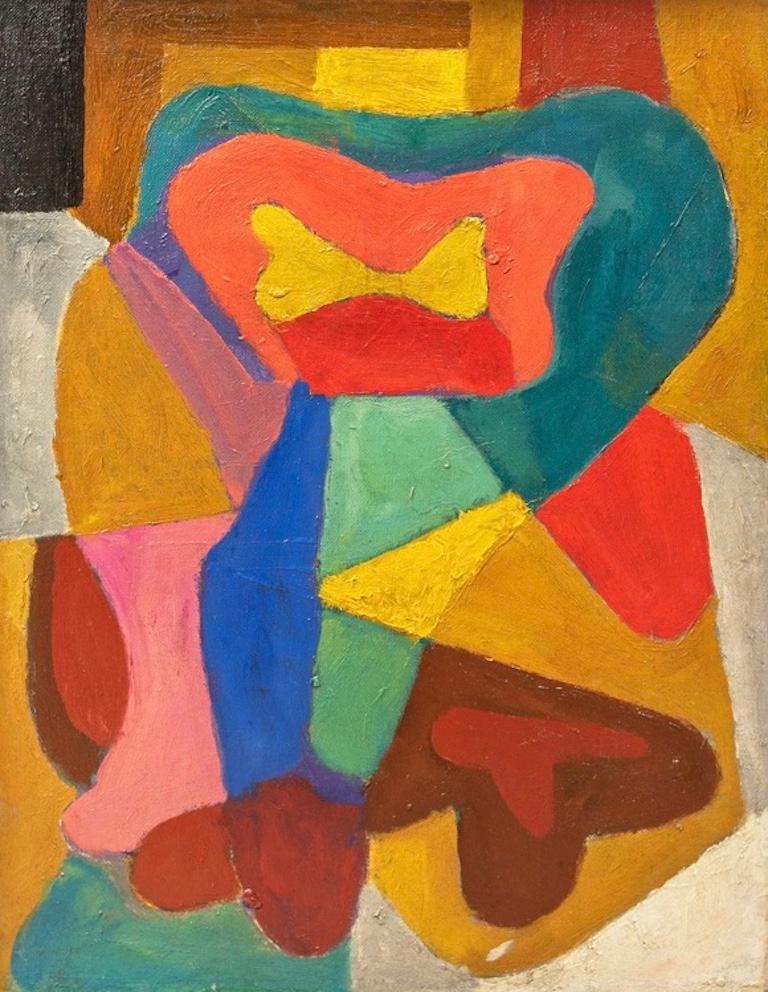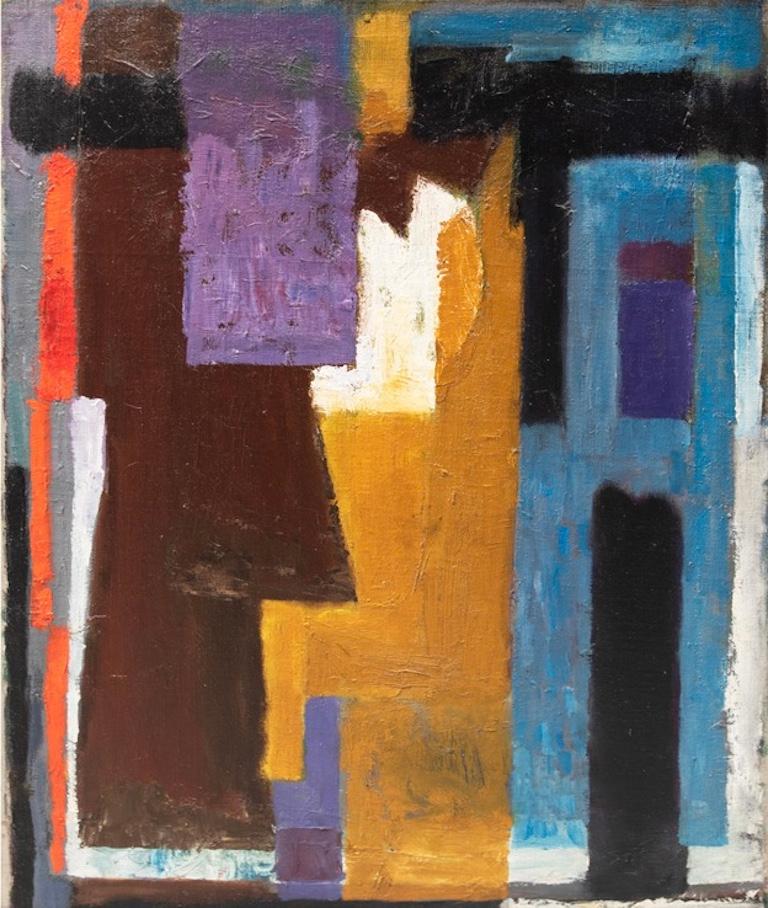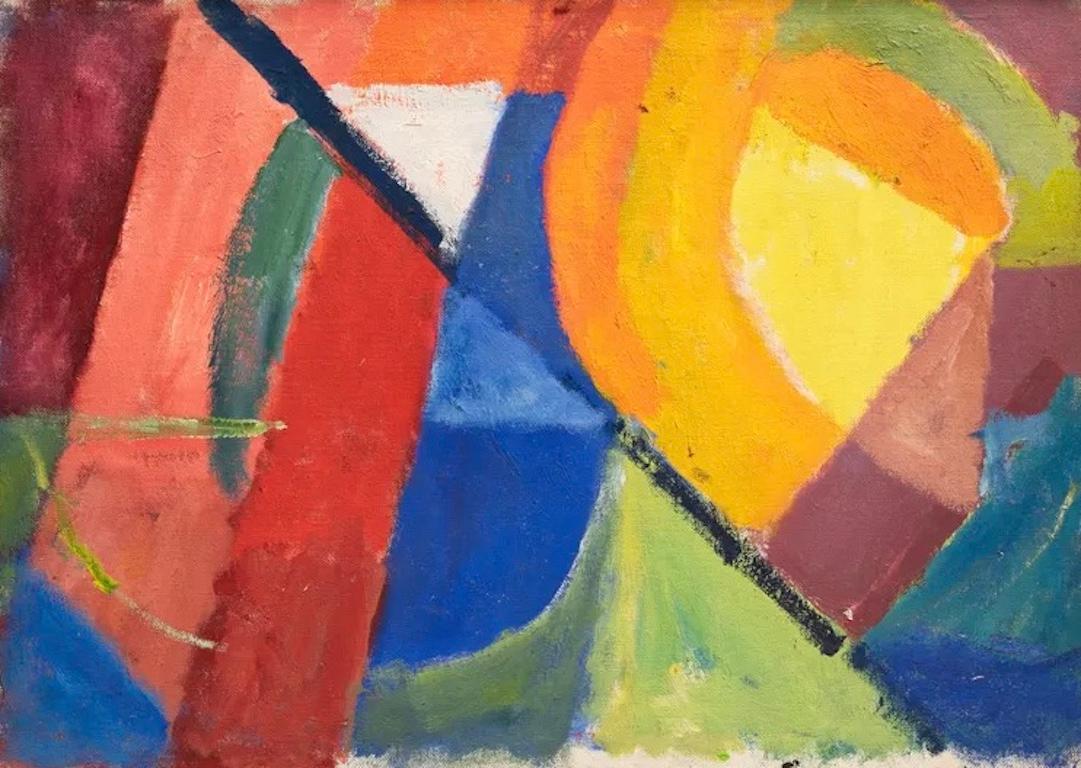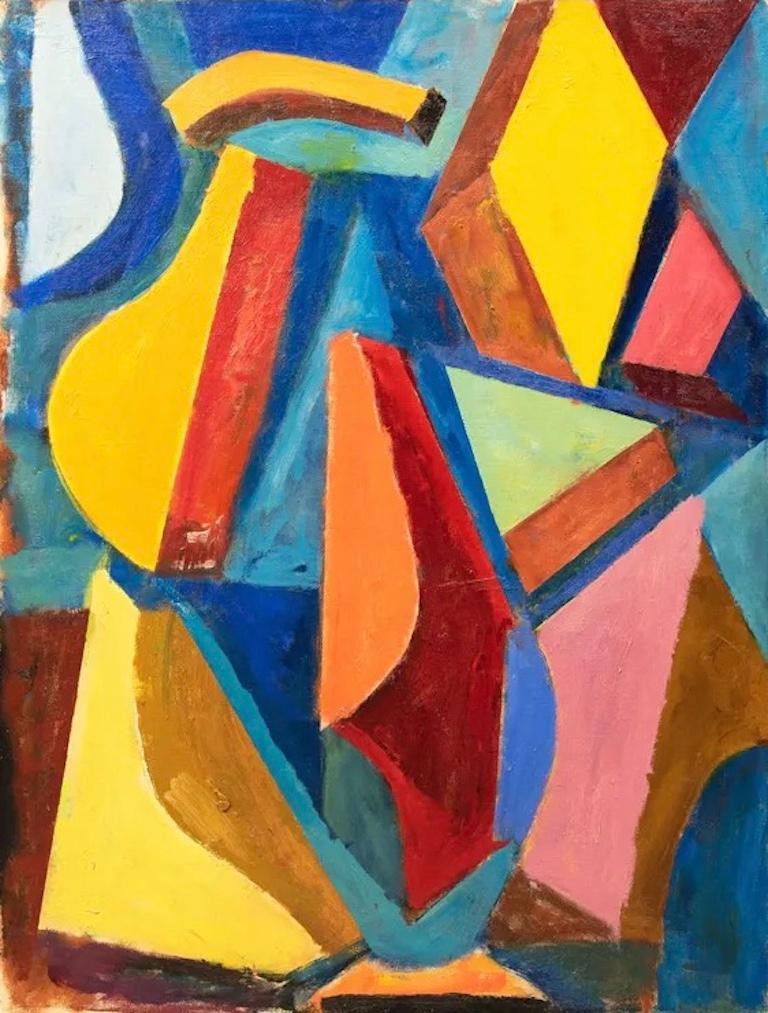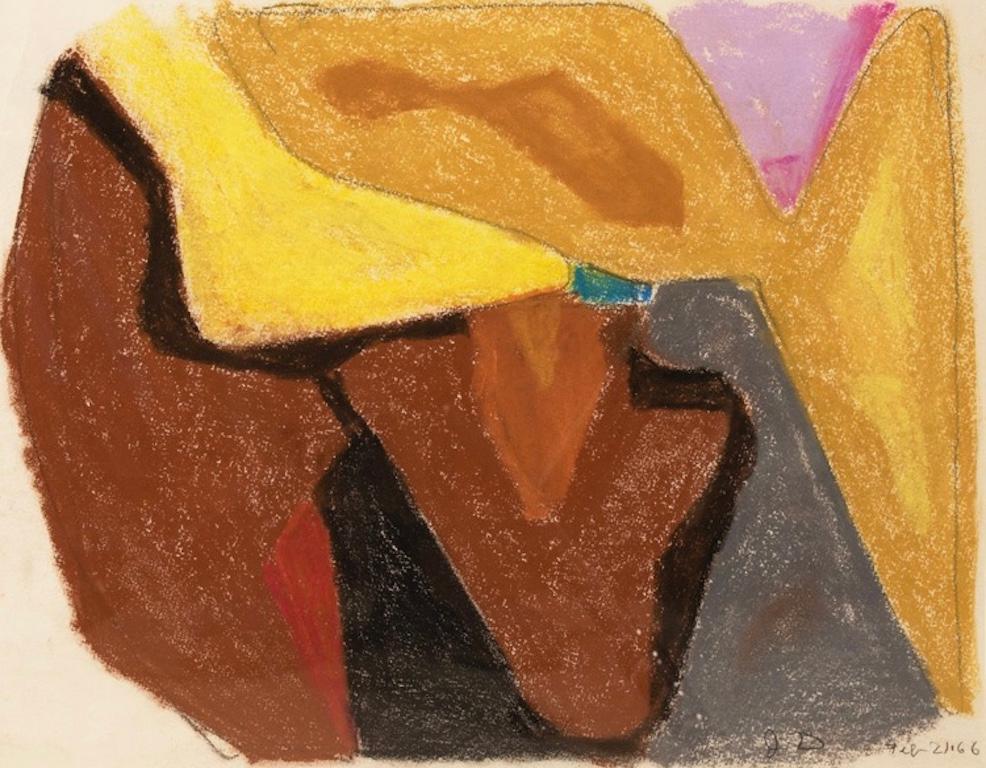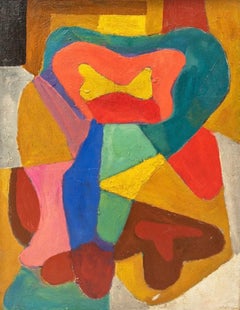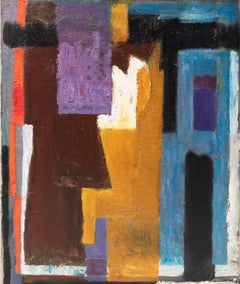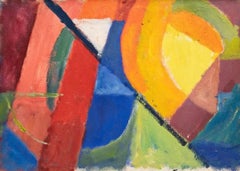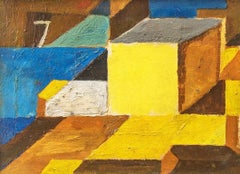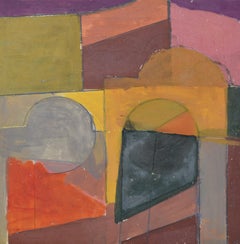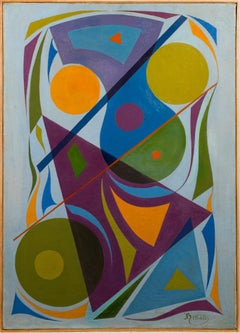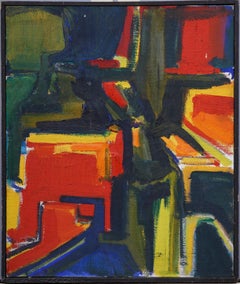Items Similar to "Abstraction" Mid-20th Century American Abstract 1960s Color Field Modernist
Want more images or videos?
Request additional images or videos from the seller
1 of 5
James Daugherty"Abstraction" Mid-20th Century American Abstract 1960s Color Field Modernistc. 1960s
c. 1960s
$8,500
£6,617.82
€7,526.37
CA$12,229.47
A$13,433.53
CHF 7,020.45
MX$160,205.99
NOK 88,897.85
SEK 82,815.84
DKK 56,240.56
About the Item
"Abstraction" Mid-20th Century American Abstract 1960s Color Field Modernist
James Daugherty (1887 – 1974)
Abstraction with White Border
16 x 12 inches
Estate stamp verso
Oil on panel
Provenance: Estate of the Artist.
Additional images are available upon request.
BIO
Among the early American modernists, James Daugherty was one of the first exponents of abstract color painting. Throughout his career, whether he was working in an abstract or a representational mode, Daugherty felt pure color to be the most effective means of creating powerful and evocative works of art.
Daugherty was born in Asheville, North Carolina, near the Great Smoky Mountains. He received his formal training at the Corcoran School of Art in Washington, D.C. and at the Pennsylvania Academy of the Fine Arts in Philadelphia during the early years of the last century. Although he was in Europe from 1905 until 1907, he remained unaffected by avant-garde art until the groundbreaking Armory Show of 1913.
Daugherty worked in a futurist manner until late 1914 or early 1915, when he came into contact with Arthur B. Frost, Jr., who had recently returned from Paris, where he had worked closely with Robert and Sonia Delaunay, the inventors of Orphic Cubism. Inspired by Frost's example, Daugherty began to explore the use of pure color in conjunction with abstract design. He soon developed a style consisting of highly complex arrangements of strips, segments, and circles of color. Daugherty quickly became one of the foremost proponents of color painting and in turn, influenced other young American painters, including Jay Van Everen. During these years, Daugherty exhibited his work at the Society of Independent Artists in New York and later with the Société Anonyme, Inc.
In the 1920s, Daugherty responded to the call for indigenous subject matter by adopting a more figurative style while retaining his former emphasis on vibrant color. He subsequently produced numerous easel paintings and murals, most notably his Spirit of Cinema America (1920; Loew's State Theatre, Cleveland). He continued his mural work in to the 1930s, but eventually devoted much of his time to illustrating children's books.
In 1953 Daugherty once again began to create abstract paintings. The first of these works, small images with relatively stable compositions and subdued palettes, suggest the influence of the work of Piet Mondrian. By the end to the decade, Daugherty had expanded to larger formats and had broken from the grid to create increasingly complex designs. In the years that followed, he alternated modes, often joining his old rectilinear format of vertical and horizontal with circles and frequently using a lighter, more refined painterly touch and layered, almost transparent color planes that recall the color veils of Mark Rothko's art.
By the mid-1960s Daugherty's work reached a peak of size, complexity, and color intensity. The explosive energies of these paintings put into physical form what Daugherty called the "out rushing forces of the cosmos" in an "ever expanding infinitude." Fusing the old and the contemporary, Daughterty referred both to early modernism and to the abstract illusionism developed by younger artists in the 1960s such as Frank Stella, Al Held, and Ron Davis. Daugherty continued to paint until the end of his life, never ceasing to experiment and find ways that abstraction could "restore meaning to life and announce its beauty and capacity."
Examples of Daugherty's paintings can be found in many important public collections, including the Fine Arts Museums of San Francisco; Ackland Art Museum, University of North Carolina, Chapel Hill; Amon Carter Museum, Fort Worth, Texas; Asheville Art Museum, North Carolina; The Columbus Museum, Georgia; The Detroit Institute of Arts, Michigan; Flint Institute of Arts, Michigan; Heckscher Museum, Huntington, New York; Hirshhorn Museum and Sculpture Garden, Smithsonian Institution, Washington, D.C.; Hood Museum of Art, Dartmouth College, Hanover, New Hampshire; Hoover Institution, Stanford University, California; The Marion Koogler McNay Art Museum, San Antonio, Texas; The Montclair Art Museum, New Jersey; The Museum of Modern Art, New York; New Britain Museum of American Art, Connecticut; Portland Museum of Art, Maine; Sheldon Swope Art Museum, Terre Haute, Indiana; Smithsonian American Art Museum, Washington, D.C.; Société Anonyme Collection, Yale University Art Museum, New Haven, Connecticut; The Spencer Collection, The New York Public Library, New York; Stanford University, California; Telfair Academy of Arts and Sciences, Savannah, Georgia; and Whitney Museum of American Art, New York.
About the Seller
5.0
Vetted Professional Seller
Every seller passes strict standards for authenticity and reliability
Established in 2008
1stDibs seller since 2019
196 sales on 1stDibs
Typical response time: <1 hour
- ShippingRetrieving quote...Shipping from: Westport, CT
- Return Policy
More From This Seller
View All"Abstraction" Mid 20th Century American Abstract 1960s Color Field
Located in New York, NY
"Abstraction" Mid 20th Century American Abstract 1960s Color Field
James Daugherty (1887 – 1974)
Abstraction
16 x 12 inches
Estate stamp verso
Oil on panel
Provenance: Estate of t...
Category
1960s Abstract Abstract Paintings
Materials
Oil, Panel
"Abstraction" Mid-20th Century American Abstract 1960s Color Field Modernist
Located in New York, NY
"Abstraction" Mid-20th Century American Abstract 1960s Color Field Modernist
James Daugherty (1887 – 1974)
"Abstraction"
58 ¼ x 41 ¾ inches
Signed and dated 1957 lower left
Oil on...
Category
1950s Abstract Abstract Paintings
Materials
Oil, Canvas
"Abstraction" Mid-20th Century American Abstract 1960s Color Field Modernist
Located in New York, NY
"Abstraction" Mid-20th Century American Abstract 1960s Color Field Modernist
James Daugherty (1887 – 1974)
Abstraction
14 x 18 inches
Estate stamp verso
Oil on panel
Provenance: ...
Category
1960s Abstract Abstract Paintings
Materials
Oil, Panel
"Abstraction" Mid 20th Century American Abstract 1960s Color Field
Located in New York, NY
"Abstraction" Mid 20th Century American Abstract 1960s Color Field
James Daugherty (1887 – 1974)
Abstraction
6 3/4 x 8 3/4 inches
Estate stamp verso
Oil on panel
Provenance: Estat...
Category
1960s Abstract Abstract Paintings
Materials
Oil, Panel
"Gravity Zero" Mid 20th Century American Abstract 1960s Color Field Abstraction
Located in New York, NY
"Gravity Zero" Mid 20th Century American Abstract 1960s Color Field Abstraction
James Daugherty (1887 – 1974)
"Gravity Zero:
24 x 18 inches
Signed on verso
Oil on panel
Provenance...
Category
1960s Abstract Abstract Paintings
Materials
Oil, Panel
"Untitled" Mid 20th Century American Abstract 1960s Color Field Abstraction
Located in New York, NY
"Untitled" Mid 20th Century American Abstract 1960s Color Field Abstraction
James Daugherty (1887 – 1974)
Untitled
12 ¼ x 15 ¼ inches
Initialed and dated February 21, 1966 lower ri...
Category
1960s Abstract Abstract Drawings and Watercolors
Materials
Paper, Pastel
You May Also Like
Abstract composition Modern British Art 1960s design by John Barnicoat
Located in London, GB
To see our other Modern British Art, scroll down to "More from this Seller" and below it click on "See all from this Seller" - or send us a message if you cannot find the artist you want.
John Barnicoat MA ARCA (1924 - 2013)
Untitled abstract composition (1968)
Tempera on board
27 x 26 cm
Initialled and dated lower right.
John Barnicoat was a painter of oils and works on paper using tempera, conté, acrylic, pen, and ink. He was brought up in Cornwall and educated at King’s College, Taunton. He joined the Royal Naval Volunteer Reserves and took part in D-Day, aged 29. He went on to read history at Lincoln College...
Category
1960s Abstract Abstract Paintings
Materials
Tempera, Board
Important Early American School Abstract Geometric Precisionist Signed Painting
Located in Buffalo, NY
Step into the enigmatic world of abstract art with this captivating original oil painting from 1945. This masterpiece, signed with a mysterious monogram by an unknown artist, embodie...
Category
1940s Abstract Abstract Paintings
Materials
Canvas, Oil
$1,996 Sale Price
20% Off
Colorful Abstract painting by Arnold Weber 1968
By Arnold Weber
Located in Long Island City, NY
Artist: Arnold Weber, American (1931 - 2010)
Title: Colorful Abstract
Year: 1968
Medium: Oil on Canvas, Signed, titled and dated l.l.
Size: 32 x 44 in. (81.28 x 111.76 cm)
Category
1960s Abstract Geometric Abstract Paintings
Materials
Oil
Early American Modernist Abstract Expressionist Framed Mid Century Oil Painting
Located in Buffalo, NY
Impressive early American modernist abstract oil painting. Framed. Oil on canvas.
Category
1960s Abstract Abstract Paintings
Materials
Canvas, Oil
$540 Sale Price
20% Off
Untitled Mid-Century Modern Geometric Abstraction
By Rolph Scarlett
Located in New York, NY
Rolph Scarlett
Untitled Mid-Century Modern Geometric Abstraction, ca. 1950
Gouache on paper painting
Hand signed on lower right front
This is a stunning original, signed vintage 1950...
Category
Mid-20th Century Abstract Geometric Abstract Paintings
Materials
Gouache, Mixed Media, Pencil
Mid-20th Century abstract geometric oil painting by Cleveland School artist
By Joseph O'Sickey
Located in Beachwood, OH
Work sold to benefit the CLEVELAND INSTITUTE OF ART
Joseph B. O’Sickey (American, 1918–2013)
Untitled, c. 1950
Oil on paper
Signed lower right
12.5 x 19 inc...
Category
1950s Post-Impressionist Abstract Paintings
Materials
Oil
More Ways To Browse
Mid Century Abstract Cubism Art
Krzysztof Gliszczynski
Large Blue Horizontal Painting
Lion King Disney
May Stevens
Mexican Vibrant Painting
Michael Haswell
Moody Dark Painting
Mud Century Painting
Mustard Seed
Nan Van Ryzin
Nicholas Roerich
Nierman Oil Painting
Oil Paintings Shanghai
Paige Powell
Paul Morin
Pointillism Abstract
R Morgan
